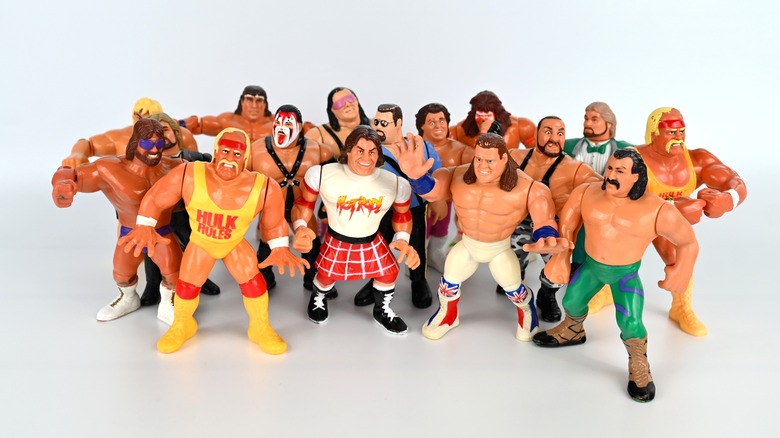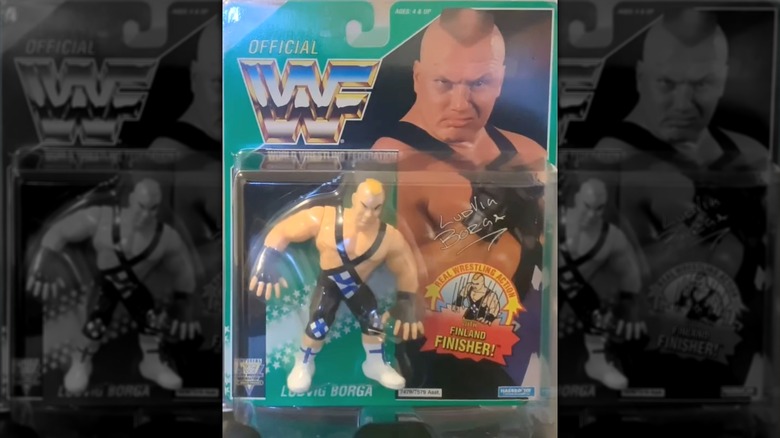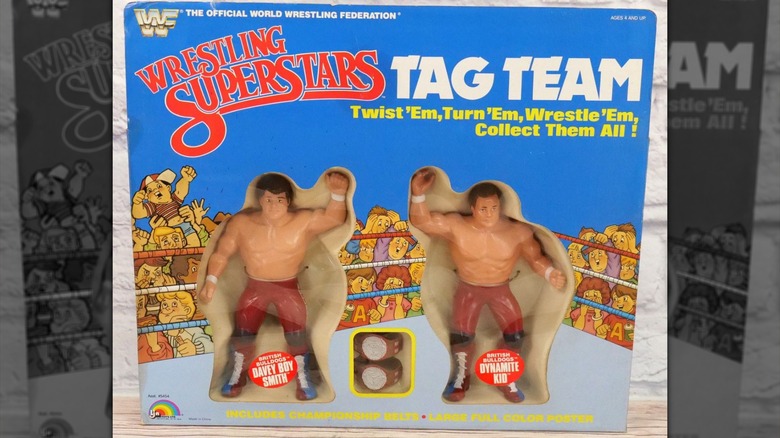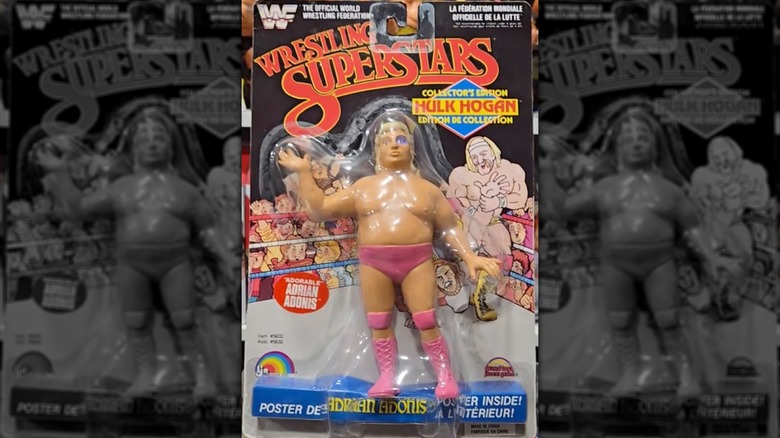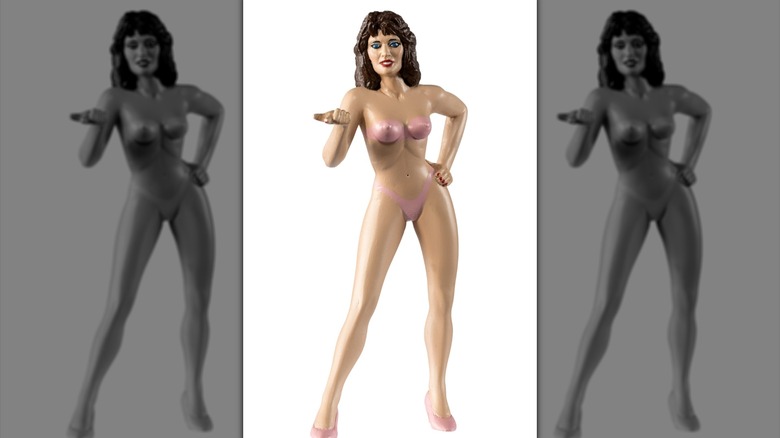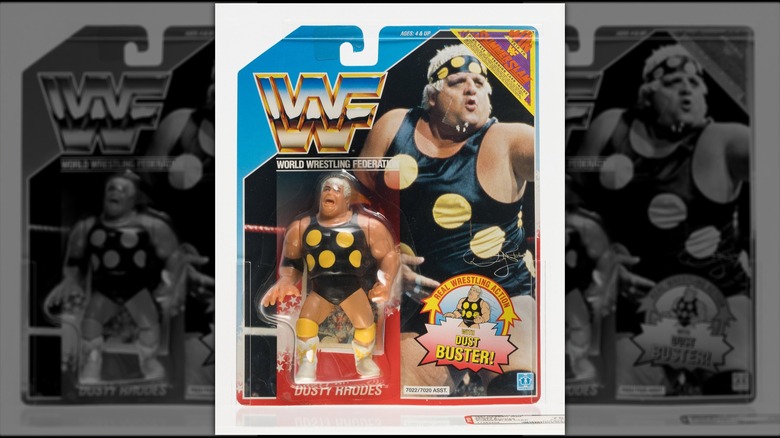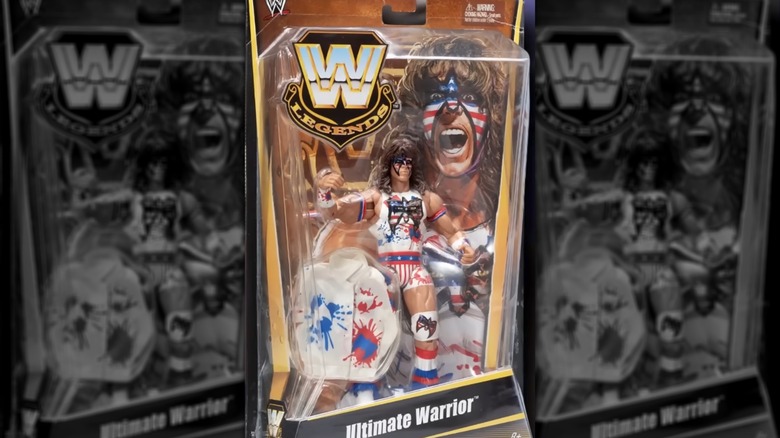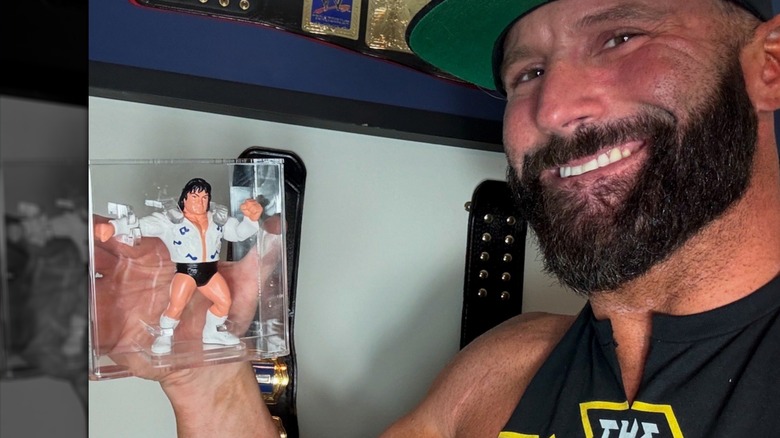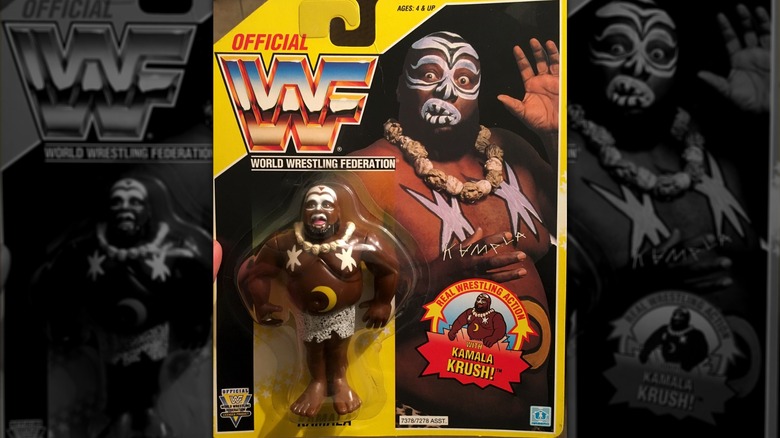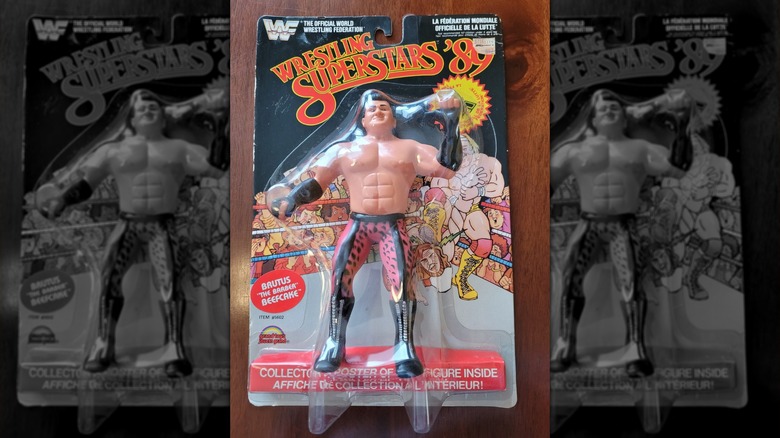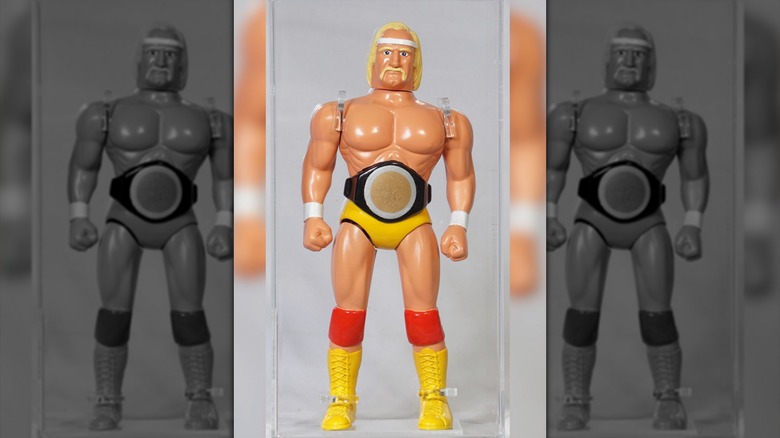WWE Toys That Are Worth A Ton Of Money
We may receive a commission on purchases made from links.
The 1980s were the best of times for wrestling action figures; it was the age of rubber behemoths, a time when giants were born and walked the earth, reaching the squared circle to the delight of millions of enthusiasts worldwide. For certain WWE (formerly WWF) fans, the real prize isn't won in the ring — it's found in a dusty attic or in a high-stakes online auction. The saga of wrestling figures began in the 1980s with the LJN "Wrestling Superstars" line, figurines that acted more like weapons than toys and captured the larger-than-life personas of the Hulkmania era. Then the 1990s arrived, bringing Hasbro and its "Real Wrestling Action" figures, smaller collectibles with spring-loaded signature moves that let kids deliver a Hulkster Hug or a Gorilla Press Slam.
Today, Mattel produces hyper-detailed Elite and Ultimate Edition figures, marvels of modern toy-making. But let's focus on what matters. This isn't a nostalgic trip, brother; it's a booming business. The global action figure market is valued at over $8.59 billion in 2025, as per Statista, and a significant share of this obscene fortune is credited to "kidults," adults who spend serious cash on toys of their youth, driving up the value of these vintage items. They are responsible for paying more than $700 for an old Undertaker WWE toy, $5,000 for an André the Giant figurine, and even shelling out for Transformers action figures worth a ton of money. So, let's ring the bell and get to the tale of the tape for some WWE toys that fetch hefty prices.
Hasbro's Ludvig Borga ($525 - $700)
Brief. Impactful. Memorable. In 1993, Ludvig Borga (real name Tony Halme), an intimidating titan from Finland, terrorized the World Wrestling Federation (WWF) with his legitimate rough-guy background. Borga made an immediate splash when he ended Tatanka's long-standing undefeated streak, but a severe ankle injury while in a match with Rick Steiner stopped dead his promising career, forcing him to leave the WWF in 1994. Because of his short tenure, Borga only received one WWF action figure, but that single figurine is among the most sought-after pieces for Hasbro collectors. Here's why. Ludvig Borga's miniature belonged to the 1994 Hasbro Series 11 lineup, the last Hasbro produced since it lost the WWF license to Jakks Pacific. So, every item in that set is cherished. For instance, a sealed example was listed on eBay with an asking price of $700, while another sample sold for $525 from the collectible dealer Brian's Toys.
Following Borga's leave from America, he continued competing in Europe, winning the CWA World Heavyweight Championship, and in boxing, becoming a two-time Finnish heavyweight champion. He even broke into the acting, writing, and musical stages, publishing books, and recording music –– his single "Viikinki" went gold in Finland. At the same time, his fame allowed him to win a seat in the Finnish Parliament in 2003. But since he'd long struggled with addictions, mental health issues, and legal problems, he suffered brain damage and stepped back from public life. On January 8, 2010, a few days after his 47th birthday, Ludvig Borga committed suicide; the body was discovered two days later.
The LJN British Bulldogs Set ($1,500)
Two blokes from across the pond brought a style Americans had never seen before. The British Bulldogs, Davey "Boy" Smith and Dynamite Kid, became a sensation by combining breathtaking high-flying, technical prowess, and incredible power and speed at WrestleMania 2. Their action figures, manufactured by American LJN, hit the shelves in a two-pack in 1986, which included the two rubber figurines with a couple of tag-team title belts and a folded poster. While individual loose figures of Davey Boy and Dynamite Kid are relatively easy to find, unearthing an original tag team set still sealed in its packaging is a different story for collectors. In the 1980s, toys were made to play hard, so for a kid, the cardboard box stood as nothing more than an obstacle between him and his new toy.
Speaking of boxes, children are the cruelest. They do not care about preserving them for future generations; they just tear them open with gusto on a birthday or Christmas morning and throw them in the trash. Because of that, the survival of an intact, factory-sealed box can reach handsome sums of money. In 2019, an unopened, pristine LJN British Bulldogs tag team sold for $1,500, as per TheSportster, and another example in a protective case, also on eBay, asked for $1,200. Some auction houses, like Bodnars Auction, are more conservative and estimate the value from $200 to $400 — likely for boxes with significant shelf wear or damage. Mint-on-card (MOC) has a kind of beauty that loose figures don't — a key principle in vintage toy collecting.
The LJN Adorable Adrian Adonis Black Card ($5,000)
In the 1980s, wrestlers reinvented themselves by changing gear or face paint because costumes were not just clothes but storytelling weapons. For example, "Macho Man" shifted from simple trunks to peacock regalia; André the Giant from traditional shorts to the iconic black singlet; and the most shocking of all, Adrian Adonis, who in 1986 shed the gruff biker leather for pastel dresses, bows, stockings, full make-up, and a new moniker: "Adorable" Adrian Adonis. This flamboyant character became one of Roddy Piper's greatest rivals, culminating in a legendary Hair vs. Hair match at WrestleMania III. Tragically, in July 1988, Adonis died in a car accident in Canada, along with Dave McKinney and Victor "Pat Kelly" Arko, also wrestlers.
His death happened just before his LJN action figure was unveiled. That figurine, a re-release of the earlier Series 6 model, belonged to the coveted 1989 LJN Black Card series, the last wave of figures produced by Grand Toys after LJN ceased operations. For collectors, a posthumously released miniature with the likelihood of low production makes it particularly hot. Its rarity is so profound that only a handful of photos have ever surfaced online to prove that MOC examples exist. For instance, a sealed "Adorable" Adrian Adonis is valued as high as $5,000, with other versions placed between $1,500 and $2,250, as published by TheToyCollectorsGuide. So, it is no longer a WWF toy but a relic of a wrestler's life and career, frozen in time.
The LJN Miss Elizabeth Prototype ($6,000)
The 1980s professional wrestling environment was a testosterone festival, so having a female figure oozing elegance and grace brought a touch of Hollywood to the fight scene. That glamorous position belonged to Miss Elizabeth (Elizabeth Ann Hulette), the "First Lady of Wrestling," beloved manager and real-life wife of "Macho Man" Randy Savage. Two events anchored Miss Elizabeth in people's hearts: when she was caught in the middle of the Savage vs. Hulk Hogan main event at WrestleMania V in 1989, and at SummerSlam 1991, when she and Savage held a kayfabe "wedding." But out of sight, their marriage had become strained, and they divorced in 1992. Soon after, she began a relationship with Lex Luger, but it collapsed under substance abuse, and on May 1, 2003, Miss Elizabeth passed away from a lethal mix of vodka and prescription painkillers.
Elizabeth's life in the WWF had gained her a well-deserved action figure, which LJN released in 1986 as part of its Wrestling Superstars line. It turned into an instant I-want-to-have-one for any fan. The standard version of the figurine came with a shimmering gold skirt; however, a small and mysterious batch with purple skirts rolled off the production line and reached distributors; that one became more valuable. On eBay, you can find a regular gold-skirted Elizabeth for around $342, but MOC purple skirts range from $350 to $1,299. But it is peanuts compared to Miss Elizabeth's prototype, which in a Heritage auction fetched $6,000 in March 2025, placing it among old action figures worth a ton of money in 2025.
The Hasbro Dusty Rhodes with polka dots ($8,000)
Do you want to own the most valuable WWF action figures? Well, look for those that capture the story of wrestling, not just the static image of the wrestler. This has to do with Dusty Rhodes. When Hasbro released Dusty's action figure as part of their highly anticipated Series 2 lineup in 1991, collectors grew impatient to add this figurine to their collections, and nothing tells more of Dusty Rhodes than the yellow polka dots on his trunks. What hobbyists got instead of that was a plastic hero featuring Dusty in plain black trunks, which was also him, of course, but it missed his legendary WWF style. But a small batch, a tiny percentage of the production, included the iconic yellow polka dots, this time perfectly matching the attire he wore with his manager, Sapphire.
Not a clue whether this line was an early or a limited-run version; what's undeniable is that its scarcity drives collectors crazy. On a good day, a standard, loose Dusty Rhodes Hasbro figure might sell for around $75. Nevertheless, the polka dot variant floats in a near-unreachable financial stratosphere. A graded mint-on-card example with an AFA 75 rating was documented to have sold on December 23, 2022, for $8,000 — you can close your mouth now. "Hard times" for those without the money. Remember that this price is not because of the figurine alone but because of the power of storyline-specific details.
The Ultimate Warrior's self-produced figure ($10,000)
Running to the ring, defying human physics, a symphony of neon colors painted on his face, the Ultimate Warrior (James Brian Hellwig) was a force of nature unlike any other. Between 1987 and 1996, he gathered a number of unforgettable wrestling moments. Twice he won the Intercontinental Championship, memorably squashing The Honky Tonk Man at SummerSlam 1988 in under 30 seconds. And his peak moment, April 1990, happened at WrestleMania VI, when he defeated Hulk Hogan to win the WWF Championship in the "Ultimate Challenge." Warrior (his legal name since 1993) was a man who marched to the beat of his own drum. He hated receiving orders, and that free spirit extended beyond the ring and into the world of collectibles.
By tradition, wrestlers license their image to toy companies, but in 2010, long after Warrior's career had ended, he took control over his brand, creating his own action figure and selling it exclusively through his personal website. This figurine, often dubbed the "USA" Warrior due to its patriotic wrapping, was underproduced by design. The production run was so infinitesimally small that only five authenticated copies are known to exist in the entire world, which, of course, makes it rarer than almost any other figure on this list — a true collector's Everest, if you will. A "USA" Warrior figure, still sealed in its original packaging, has been documented to sell at the same price as old movie posters worth $10,000. Even a loose, out-of-package version can fetch $2,500. Expensive indeed, but not as much as the next one.
Hasbro's Greg The Hammer Valentine Prototype ($15,500)
Through the history of this toy, you can watch how the unpredictable world of professional wrestling impacts the collectibles market. In 1991, the landscape of the WWF kept shifting, and Greg "The Hammer" Valentine, a rugged, hard-nosed brawler, went through a polished makeover. He dyed his hair black, donned some flashy duds, and teamed up with The Honky Tonk Man to form the "Rhythm & Blues" duo. Hasbro spotted an opportunity, rushed to create a tag team to capitalize on it, and even teased the upcoming figure in a Toys "R" Us advertisement in the WWF Magazine. Everybody felt ready to add the pair to their collection, but then disaster struck: The Honky Tonk Man parted ways with the WWF. The figure was abruptly canceled and never saw a public release.
Only a handful of pre-production prototypes, literally, left the factory — the current consensus says that only three or four exist in the world. Over the years, its legend has grown thanks to WWE Superstar Matt Cardona (Zack Ryder), who has owned and chronicled the sales history of these prototypes. In 2013, one of them appeared on eBay selling for $12,600, according to Wrestling Figure News, while another sold at auction for a staggering $15,500 in 2014. A little-damaged version later fetched around $6,000 before being acquired by Cardona for $8,000 and then sold to a different hobbyist. Most recently, collector Marc Reynolds purchased one for a price that he stated "comfortably surpassed" the $13,000 he'd previously spent on a single figure. Just like a rare Liberty Head nickel worth a fortune, this character model is a collector's dream.
The Hasbro Kamala Moon Belly variant ($21,000)
Say you own pennies worth a ton of money; their high value comes from a mistake, such as a double strike. But with Hasbro Kamala "Moon Belly," the situation is reversed because the mass-produced figure was the one with the error, while the rare and valuable version corrected it. Regarding scary WWF superstars, few were as intimidating as Kamala, "The Ugandan Giant," a massive, terrifying wrestler popular for his tribal makeup and a unique yellow moon painted on his enormous belly. So, when Hasbro released his action figure in 1993, fans were thrilled — until they tore open the packaging. Surprise, surprise, they got a bright yellow star on Kamala's stomach instead of the signature moon — a colossal blunder. How come it happened? So far, it's a mystery.
Was it a last-minute design change, or the company's designers had no clue how Kamala looked? This is where the story gets interesting and expensive. Millions of "Star Belly" Kamalas hit the shelves, but a microscopic batch surfaced with the right, character-accurate moon painted on the belly — so tiny that it's believed that only 24 of these figures were ever created. A mint-in-box, AFA-graded (Action Figure Authority) Kamala "Moon Belly" can reach up to $22,000. An example, graded 80 by the Collector Archive Services (CAS), was listed on eBay with an asking price of $21,000. Even out of its packaging, a loose figure can fetch thousands of dollars, so if you happen to have one, or know someone who does, don't panic; find an expert, authenticate it, and above all, keep it in a safe place before selling it. This character model is comparable to sports collectibles, likely to increase in value with time.
The LJN Brutus The Barber Beefcake Black Card ($25,000)
A certified superstar, Brutus "The Barber" Beefcake ranks among the most colorful and beloved characters of the entire World Wrestling Federation. Obvious reasons are his wild outfits, oversized hedge clippers, and, the craziest of all, a penchant for giving his defeated opponents an unwanted haircut. His LJN action figure was a staple in every kid's toy box, a necessary good guy to stand alongside Hulk Hogan to fight the forces of evil. Beefcake's standard figurine is a common piece, reaching prices between $17.99 and $40 on eBay, but the one that really brings in astronomical bids is the rare Black Card because of the story behind it. By the end of the 1980s, children's tastes were shifting from solid rubber toys to video games like those from Nintendo — a new form of entertainment that offered unlimited hours of fun.
For this reason, in 1989, the LJN toy company, now part of Acclaim Entertainment, ended its toy arm to repurpose its business to the more profitable game cartridges. However, Canadian Grand Toys acquired the rights and the existing molds to produce one last wave of the iconic Wrestling Superstars line, which, as you guessed, was packaged on a new black card back and had an extremely limited distribution mainly on Canadian soil. So, American fans got only a few of them through mail-order advertisements. Over the years, Beefcake's figurine worth has skyrocketed, with reports of that action figure fetching bids as high as $25,000. This immense value stems not only from low production numbers but also from the fact that it means the "final curtain call" for an entire generation.
The LJN Hulk Hogan resin prototype ($75,000)
You might have a Hulk Hogan action figure from the 1980s on a shelf in your living room. Maybe not in its original packaging, but still in good condition. But this last collectible is not related to the red shirt or white shirt LJN figurine you had as a kid at all. What this prototype represents, ladies and gentlemen, is the genesis of Hulkamania in plastic form, the Adam of wrestling action figures, the master used to create the millions upon millions of Hulkster figures that followed. So its rarity is impossible to overstate, and it is literally a one-of-a-kind production cast mold figure. The thing that sets this item apart — and separates a mere toy from a museum-quality piece — is its origin, a golden thread that traces directly back to an LJN employee named Mary Butcher, giving it a lineage that collectors would pay a king's ransom for.
At the absolute peak of the 1980s wrestling boom, Hulk Hogan (R.I.P) was more than a wrestler; he was a superhero, a pop culture icon, and the face of a global phenomenon. Thus, owning a prototype like this one isn't only about having a collectible toy. An eBay listing from the reputable seller "texasvintagecollectibles" has the figure priced at a mind-blowing $75,000. The seller's own story highlights its incredible journey, noting that he first bought it for $5,000, sold it for $25,000 years later, and then traded a near-mint Babe Ruth card to get it back. But other Hogan prototypes have been valued higher, with estimates reaching $50,000 and even $120,000, according to TheSportster. Undeniably, this model captures the birth of an idol, and you can't put a price on that... well, actually you can, and it's at least $75,000.
